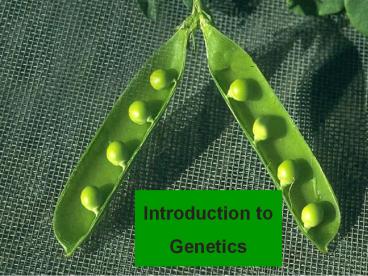Introduction to PowerPoint PPT Presentation
1 / 26
Title: Introduction to
1
Introduction to Genetics
2
(No Transcript)
3
Weve all heard of it, but What is genetics?
- Genetics the study of gene structure and action
and the patterns of inheritance of traits from
parent to offspring.
4
Ancient ideas about genetics
- Selective breeding of plants and animals
5
Ancient ideas about genetics
- Theories why offspring resemble parents
- Spontaneous generation?
- Miniature pre-formed organisms?
- Blending of vital fluids?
6
Then, in 1860
- Gregor Mendel successfully discovered genetic
principles
7
Pea Characteristics
- Mendel studied traits of pea plants one at a time
8
Mendel and Plant Breeding
- Mendel examined thousands of crosses and
offspring - Mendel analyzed his results mathematically- saw
patterns no one else saw
9
Mendels experiments
10
Mendels Principle Findings
- Dominant and Recessive
- Certain characteristics are dominant to others
- The dominant trait will mask another (recessive)
trait, preventing its expression - The recessive trait disappears for a generation
11
(No Transcript)
12
Mendels Principle Findings
- Law of Segregation
- For each trait, organisms have 2 genes
- (which may be different versions or forms of the
genes, these are called alleles) - Each pea plant got one gene from each parent
- Genes are segregated from each other during egg
or sperm formation (meiosis)
13
(No Transcript)
14
Remember Meiosis?!?The Law of Segregation is the
SAME THING!Mendel just theorized about it before
it was actually discovered.
15
Segregation of Genes during Meiosis
B
sperm
B
B
Bb
haploid (n)
b
b
diploid (2n)
b
meiosis II
meiosis I
16
Mendels Principle Findings
- Independent Assortment
- Factors for different traits are distributed to
reproductive cells independently - Later it was seen that orientation of homologous
pair to poles during meiosis is random. - So, for example, genes from the individuals
mother don't all stay together
Click here for an animation!
17
(No Transcript)
18
Some terms
- Trait characteristics of an organism passed
from generation to generation. - Eye color
- Skin color
- Hair color and type
- Height
- Temperament
- Symptoms for genetic diseases
19
Not all traits are easy to predictFor example
polygenic inheritance. (Where have we seen the
prefix poly before?)
20
Genotype
- Tells you the genetic makeup of the organism
- The genes the organism carries
21
Genotype
- Written using symbols
- Each allele is represented by a letter
- Tall T dominant
- Short t recessive
- Capital letter designates the dominant trait and
lower case letter designates the recessive trait. - Capital letter is always written first.
22
Homozygous
- An individual which contains one allele for a
genetic trait - TT-- homozygous dominant
- tt -- homozygous recessive
23
Heterozygous
- An individual which contains different alleles
for a genetic trait - Tt heterozygote
24
Phenotype
- What the organism looks like
- Controlled by the genotype
- TT---------- tall
- Tt----------- tall
- tt------------ short
TT
Tt
tt
25
Remember
26
Example
Phenotype
Genotype
This person would have brown eyes (Bb)

